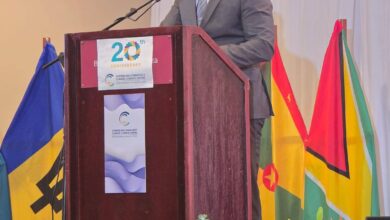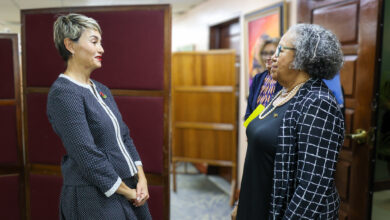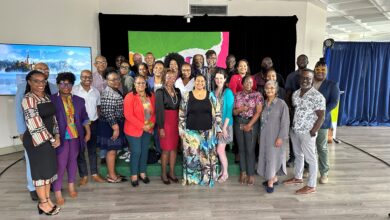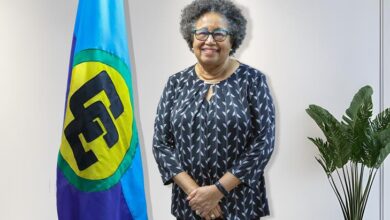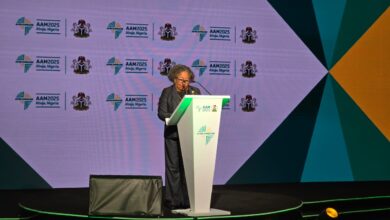“The project encourages local youth to understand, appreciate, and advocate for the protection of these vital ecosystems, aiming to inspire lifelong environmental commitment among the next generation.”
Esquire Henry, CARICOM Youth Ambassador (CYA)-Antigua and Barbuda
Young people in Antigua and Barbuda are learning about the importance of the country’s rich mangrove ecosystem, thanks to Esquire Henry, CARICOM Youth Ambassador (CYA), and his team of local youth leaders. The Wetland and Coastline Assessment and Management Project, developed for the EU CARIFORUM Climate Change and Health Project (CCH), blends hands-on learning with educational resources to increase awareness and inspire action among Antigua and Barbuda secondary school students. The project, which launched in September, has already engaged 90 participants from six local schools.
During the first phase of the project, students visited three local mangroves. In the sessions, representatives from the Environmental Awareness Group (EAG) provided insight into the ecosystems’ critical role in protecting the country’s coastlines, sustaining biodiversity, and building climate resilience.
The students also participated in birding activities as part of the field trips, which were held on World Migratory Bird Day, getting a close look at some of the diverse birds that breed and nest in the island’s mangroves. Henry explained that these hands-on experiences are crucial to the project’s long-term success:
“Antigua and Barbuda’s mangroves are extremely important in protecting coastal areas from natural disasters while also providing food and shelter for diverse wildlife. Unfortunately, mangrove ecosystems are increasingly threatened by human activities. The project encourages local youth to understand, appreciate, and advocate for the protection of these vital ecosystems, aiming to inspire lifelong environmental commitment among the next generation.“

In addition to coordinating the immersive field trips, the project team developed a booklet that shares information on the four types of mangroves in Antigua and Barbuda, highlights man-made and environmental threats to these ecosystems, and provides resources to aid teachers in bringing environmental science into the classroom.
“Our goal is to eventually print and distribute the booklet nationwide so that all students have access to this vital information,” Henry stated.
For Henry and his team, which includes Chrysean Jarvis, Esther McKenzie, and Ahmiah James, building a cadre of budding environmental activists is the ultimate goal.
“We’re working to inspire youth from a young age, building them up as advocates for the environment,” he explained. “Many people don’t understand the critical role of mangroves in disaster resilience and habitat preservation. Our students are now seeing these ecosystems firsthand, and we’re providing them with knowledge and tools to spread this awareness among their peers.”
Building knowledge, leadership, and action
Henry noted that the project’s final phases would empower students to implement environmental initiatives, feeding into the larger goal of creating a new generation of climate activists.
In the third phase, participants will attend workshops where experts will guide them through the steps required to develop, sustain, and manage environmental projects. In the fourth phase, participants will use the training to create proposals based on their ideas and compete for up to USD$500 in seed funding for their projects.
Despite a few initial hurdles, Henry said, the outcomes are promising. The support from the corporate sector has been strong thus far.
“Local organisations such as the Antigua and Barbuda Transport Board, Subway, the Environmental Awareness Group, Flow, Brownie’s Bakery, Top Ranking, and the Department of Youth Affairs have provided essential sponsorship,” Henry said. “They did not hesitate to come on board, providing refreshments, tents, and other logistics for the field trips, all of which kept our participants comfortable and engaged during the sessions. We are deeply appreciative of their support.”
In addition, participants are enthusiastic about the project and are eager to share what they are learning with their peers, parents, and communities. The project is also receiving buy-in from educators as more schools are expressing interest in taking part.
Henry recognises the invaluable support from the CARICOM Secretariat, EU and PAHO. The critical resources and funding provided by the organisations were crucial to ensuring the initiative was implemented.
Expanding to Barbuda and beyond
Henry and his colleagues hope to extend the project’s reach and impact in the coming months. Plans are underway to introduce the project in Barbuda in late November or early December. The team is also finalising sessions targeted at junior grades, which will allow them to integrate primary schools and students from lower secondary forms.
“By reaching students as young as 12, we aim to foster a generation of environmental stewards who understand the value of wetlands and mangroves,” said Henry.
The Wetland and Coastline Assessment and Management Project is funded by the PAHO-coordinated EU CARIFORUM Climate Change and Health Project and implemented by the CARICOM Secretariat.


